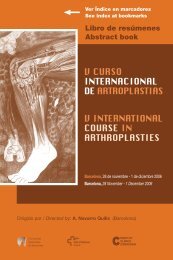Notas / Notes - Active Congress.......
Notas / Notes - Active Congress.......
Notas / Notes - Active Congress.......
You also want an ePaper? Increase the reach of your titles
YUMPU automatically turns print PDFs into web optimized ePapers that Google loves.
MIÉRCOLES / WEDNESDAY<br />
84<br />
15.15 - 18.30 h<br />
CADERA / HIP<br />
Cadera de revisión / Hip revision<br />
Moderador: Antonio Coscujuela<br />
SURGICAL TECHNIQUES IN REVISION<br />
HIP ARTHROPLASTY<br />
Peter McLardy-Smith and the Oxford Hip & Knee Group<br />
Nuffielsd Orthopaedic Centre,<br />
Oxford (Great Britian)<br />
Revision hip arthroplasty is an increasingly important problem<br />
with numbers and technical difficulty increasing. One of the<br />
major challenges is bone loss and successful outcome is inversely<br />
related to the extent of bone deficiency.<br />
In the femur weakened or absent bone can be by passed<br />
by devices which rely on distal fixation in the diaphysis, but<br />
this will lead to proximal stress shielding and further weakening<br />
of remaining proximal femoral bone. Impaction allografting<br />
is an established technique aiming to reconstitute the proximal<br />
femoral bone by cementing a polished tapered wedge in to<br />
the graft construct. This paper describes the use of a specific<br />
modular device (the Oxford Universal Hip) in which the metaphyseal<br />
portion slides over the diaphyseal stem, but is not<br />
fixed to its surface so that it is free to sink or rotate on the<br />
stem. The stem can therefore by bypass distal defects and<br />
the bone impaction is needed only in the metaphyseal portion,<br />
where the load transfer occurs.<br />
Using this technique we have studied 173 hips, in which<br />
there were severe metaphyseal defects (Paprosky Grade<br />
3A or worse). Using the Oxford Hip Score there was a highly<br />
significant improvement in score post operatively and the<br />
worst case survivorship is 93%. A mean of only 1.8 femoral<br />
heads were required for the impaction grafting. Post operative<br />
fractures at the tip of the previous failed prosthesis are<br />
eliminated by the long stem and because the polished wedge<br />
was cemented into the graft construct, local antibiotics<br />
delivery is enabled from the cement.<br />
CEMENT-IN-CEMENT REVISION<br />
-DECREASING THE MORBIDITY OF<br />
REVISION SURGERY<br />
A. John Timperley<br />
Princess Elisabeth Orthopeadic Hospital,<br />
Exeter (Great Britain)<br />
IMPACTED BONE GRAFT<br />
IN FEMORAL REVISION<br />
Aaron G. Rosenberg MD<br />
Professor of Orthopaedic Surgery Rush Medical College<br />
Chicago, Illinois (USA)<br />
The revision technique of of impacting allograft bone chips<br />
into the proximal femoral canal and then using cement to fix<br />
the stem in the newly “created” allograft neo-endosteal canal<br />
allows for better cement fixation at the endosteal surface by<br />
improving the quality of the bone present for cement interdigitation<br />
while allowing for bone stock restoration to the<br />
upper end of the femur. This is a particularly appropriate<br />
technique in the patient who has substantially compromised<br />
endosteal bone stock or substantial endosteal expansion<br />
(the so called patulous proximal femur). This technique may<br />
also be helpful when used above long distal cement columns<br />
that may be difficult to remove and can be used to support<br />
the bone packing above. The procedure is technique dependent,<br />
requires appropriate equipment and should be used<br />
after appropriate training.<br />
Several centers have reported intermediate-term results,<br />
most often using stems of a similar geometry: a double-





